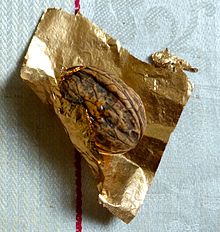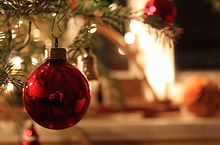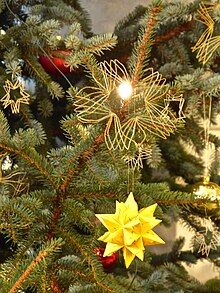Christmas tree decorations
The Christmas tree decorations or Christmas tree decorations include all decorative elements with which the Christmas tree is decorated, in the broader sense also the candles .
history
According to the latest research findings, the Christmas tree developed from the paradise tree ( Paradeisl ), which was used in the medieval Paradise Games on December 24th. The paradise tree was decorated primarily with apples , but also with baked goods and colorful flowers made of paper. According to the available sources, the first known Christmas trees in Alsace were also decorated with these elements. At the beginning of the 20th century, Adam and Eve and a snake were part of traditional Christmas tree decorations in northern Germany , as December 24th was the day of Adam and Eve's remembrance in the liturgy . In the Bible's tale of paradise ( Gen 3 EU ), a snake induced Eve and Adam to eat the forbidden fruit of the “tree of knowledge” - usually represented as an apple - contrary to God's instruction . According to the Christian understanding, this fall into sin through “disobedience” of the first Adam was atoned for by the birth of the “second Adam” Jesus Christ at Christmas, his life and his “obedience” “until death on the cross” ( Romans 5 : 12-21 EU ; Phil 2.8 EU ).

Since before the 19th century mainly apples (mostly Christmas apples ), nuts, pastries and sugar products were hung on the tree, the Christmas tree was also known regionally as the sugar tree . This is what the poet Jean Paul calls him in his novel Der Jubelsenior, published in 1797 : "In some of the next houses the fruit or sugar trees were already lit and the (...) children jumped around the burning branches and the silver-plated fruit". At ETA Hoffmann , his fairy tale Nutcracker and Mouse King says: "The big Christmas tree in the middle bore lots of golden and silver apples, and like buds and blossoms, sugared almonds and colorful candies and whatever other nice sweets there are, sprouted from all the branches" .
In addition to sweets, gold-plated and silver-plated elements also played an important role very early on, especially apples and nuts. Initially, there were no commercially made Christmas tree decorations, but they were made entirely by the families, usually new for each Christmas. For this, a number of books with appropriate handicraft instructions and decoration suggestions were published. This custom lasted until the 20th century, but was gradually largely superseded by the newly introduced glass jewelry and industrially manufactured tinsel .
The Christmas tree decorations made for the time of the two world wars occupy a special position . During the First World War , Christmas tree balls in the form of bombs and grenades were produced, and Christmas tree decorations in the form of warships and airplanes were also hung on the Christmas tree. There were also Christmas tree balls with the motif of the iron cross . During the Second World War , Nazi members decorated their Christmas trees with Christmas tree baubles on which Nazi symbols (preferably the swastika ) appeared. The head of Adolf Hitler was also reproduced as a Christmas tree ornament.
species
Pastries and sweets
The oldest reports about decorated Christmas trees almost exclusively mention edible tree hangings. Since the 18th century were very popular so-called Model -Gebäcke from a dough , which in Franconia eggs sugar and in Swabia and Bavaria Springerle was called. As early as the Middle Ages , models were used for baked goods. Many of the motifs that served as tree decorations had nothing to do with Christmas , but corresponded to the respective zeitgeist. Often animals or toys were modeled. The finished baked goods were decorated in bright colors in the families. In the 19th century often were Gingerbread with wafers also - Scrap called - stuck, destined for scrapbooks.
In addition to pastries, so-called sugar stuff was common as jewelry. In the 18th century, sugar dolls were made from sugar paste with the help of molds. The sugar was subsequently replaced by a mass that partly consisted of tragacanth as a binding agent and was therefore called that. This mass was also used for model figures and then painted. The confectioners made such figurines in large quantities before Christmas. In the 19th century, figures made of marzipan were added, which were mostly hung on the tree in small baskets or nets. Fruits and animals were popular motifs. In addition, candy canes came into fashion as tree decorations.
Paper, straw and related materials
Before the 19th century, Christmas tree decorations were mainly made by families themselves, even if some decorative elements were already available to buy at the Christmas markets. For example, colored chains were made out of paper and wrapped around the branches. All kinds of objects were cut out of sturdy colored cardboard paper and hung, there were also instructions for three-dimensional objects. After the appearance of the picture sheets, which were mainly produced in Neuruppin , they came into fashion as tree decorations. Christmas tree decorations made of cardboard were also mass-produced industrially in the 19th century, sometimes as handicraft sets, from which the individual elements were then made at home. The cardboard jewelry made of imitation metal, the so-called Dresden cardboard, was particularly attractive . Often the motifs were not at all Christmassy. Carriages and toys, for example, were popular, but also technical items such as locomotives or hot air balloons , and at the beginning of the 20th century, zeppelins in particular .
In the 19th century, small figures were often made from paper and cotton wool , especially by home workers in Saxony and Thuringia . In 1901, a catalog in Breslau offered 30 different cotton wool figures for Christmas. From 1870 to around 1910, Sebnitz was a center of handmade tree decorations ( Sebnitzer Christmas tree decorations ). Paper mache items were also commercially made for Christmas. The traditional production of tree decorations from various materials such as paper, straw and cotton wool has persisted in some families into the 21st century and is also cultivated in day care centers and primary schools in the run-up to Christmas. The stars are a particularly common motif .
Glass jewelry
The glass Christmas tree decorations were mainly made by home workers in Thuringia since the middle of the 19th century . According to a legend , the idea of making colored glass balls for the Christmas tree came from a poor Lauscha glassblower who in 1847 could not afford the expensive walnuts and apples . That is why he is said to have inflated small bottles of oil to make glass decorations for the Christmas tree. This story cannot be substantiated; the raw material had to be obtained from a glassworks in any case and was not free. The order book of a glass blower has been preserved, in which an order for six dozen “Christmas balls” in various sizes is recorded for the first time in 1848; so they were not made for your own tree.
In the early days of production, glassblowers used a harmful alloy of tin and lead to mirror the glass surfaces. From 1870 the spheres got their shine from silver nitrate , which is still used today in the manufacture of mirrors. The publishing houses from Sonneberg took over the distribution . The mass production of this new tree ornament was made possible by the construction of a gas station in Lauscha in 1867, because only a very hot gas flame made it possible to blow large and thin-walled balls. Before that, the Bunsen burners were operated with rapeseed oil and paraffin . The mirrored spheres were then dipped in paint by the family members and sometimes even provided with mica particles.
In 1870 Justus von Liebig succeeded in coating glass bodies with a silver solution and making them shine. However, Liebig was not concerned with his invention of Christmas decorations (Christmas tree balls), but of scientific equipment.
Around 1880, the American Frank Winfield Woolworth imported the first Christmas tree balls to the United States. As a result, production was greatly expanded. Until 1939 there were balls and figural Christmas tree decorations that were blown into different shapes. With the establishment of the Meininger Oberlandes eG glassblower cooperative in 1907, production was given a further boost and the profit margins for glassblowers rose. With their success in exporting their glassware, the effects of inflation and the economic crisis in Germany were also mitigated.
Initially, the Thuringian manufacturers were almost unrivaled, only in Gablonz in what was then Bohemia was an independent Christmas tree decoration made from hollow glass beads and mainly thin glass tubes, which had little in common with the Thuringian from Lauscha, for example. Before the First World War , a Viennese company also got into the business, and from the 1930s there were other manufacturers of glass jewelry in Poland and also in the United States, until then the most important importer.
Two years after the end of the Second World War , the family businesses started production again. Later, in the GDR , the state- owned enterprises (VEB) took over the manufacture of glass art and glass jewelry by means of mechanical mass production. In the Federal Republic of Germany , balls made of plastic , which were less fragile, became increasingly fashionable since the 1950s . In the glass-blowing town of Lauscha , glass Christmas tree decorations are still made using traditional craftsmanship. Today all major retailers and the Christmas markets offer a large selection of Christmas tree decorations in a wide variety of designs, including curiosities such as Christmas cucumbers .
In the manufacture of hand-blown glass spheres, the glass blank is slowly heated to reduce the tension and the risk of jumping when inflated. The raw glass tube is then heated to around 800 ° C in the flame of a gas burner . The shape or figure is created by blowing into molds after constant rotation. The glassblower uses molds made from a special ceramic material. In mass production, the shape, here the tools are usually made of graphite or metal, is made by machines. For technical reasons, however, the variety here is not as great as with items made by hand. With simple, smooth balls and other basic shapes such as olives, onions or tree tops, the articles are blown without shapes. After being removed from the blow mold, the balls are briefly passed through the flame again in order to relieve the tension created by the sudden cooling. This reduces the risk of jumping later. To cool down, the balls are then placed on a so-called nail board; In the mechanical process, the balls are placed on a cooling section, which also reduces the stresses through repeated heating and slow cooling. Next, the interior of the glass balls or figures is coated with a silver nitrate solution. The balls are then painted, decorated and the pendant is attached after the handle, known as the "skewer" for hand-blown tree decorations, has been removed.
Candles
The first Christmas trees were not yet lit. In the 17th century, the custom of decorating the tree with candles arose in noble families; this fashion was picked up by the upper middle class and finally became generally accepted. Because beeswax was expensive, sebum was widely used prior to the 19th century and was poured into walnut halves. It was only with the invention of stearin (1818) and paraffin (1837) that inexpensive candles could be made.
The attachment of the candles or tallow lamps initially proved difficult because there were no special candle holders. The upper layers wrapped wax sticks around the branches or attached the candles directly to the branches with the help of hot wax, others used needles to pin them. The first candle holders for Christmas trees were patented in 1867, and the clamp holder was first launched in the United States in 1879. In addition to the clamp brackets, pendulum brackets have also been developed that are hung loosely over the branches and held upright by a hanging weight. A special form are so-called "Berlin candle holders", which are not attached to the branches, but screwed into the trunk of the Christmas tree.
In 1901, the General Electric Company advertised the first electric Christmas tree candles. Six years earlier, the President of the United States , Grover Cleveland , had his Christmas tree in the White House decorated with over a hundred brightly colored electric candles. Electric Christmas tree lighting gradually spread from the 1920s. Since the 1950s, electric candles have been used more and more for safety reasons.
Tinsel and bows
The tinsel was developed as an innovation in Nuremberg in 1878. As a Christmas tree hanging, tinsel symbolizes the appearance of icicles and was therefore originally made exclusively in silver color. Gold tinsel appeared at the end of the 20th century. Instead of tinsel, bows or ribbons are used in some places.
See also
- Johann Wanner , manufacturer and dealer of handmade Christmas decorations
- Käthe Wohlfahrt , in the same branch
- Berchtesgadener War , or hand-carved wooden toys , have been hung on the "Berchtesgadener Christmas tree" in the inner district of Berchtesgadener Land since 1911 .
literature
- Alfred Dünnenberger-Hager: O you happy, o you blessed, gracious Christmas season. Self-published, Baar 2015 (documentation of the Dünnenberger collection of historical Christmas decorations from the period between 1850 and 1950), ISBN 978-3-03808-008-4 .
- Manfred Klauda: The story of the Christmas tree. Center for Extraordinary Museums, Munich 1993.
- Wolfram Metzger, Jutta Tremmel-Endres: trees shining, trees dazzling ... historical Christmas tree decorations. With texts by Hinrich Behning and Helmuth Thoma. Info, Karlsruhe 1996, ISBN 3-88190-209-0 (catalog for the exhibition of the Badisches Landesmuseum 1996/97).
- Museum für Volkskunde Berlin (Ed.): Christmas tree decorations. Catalog, Berlin 1992.
- Ralf Rossmeissl: "Shine and Glitter". Tinsel - Christmas tree decorations from Roth & Allersberg. Bad Windsheim 2002 (book accompanying the exhibition of the same name in the Franconian Open Air Museum Bad Windsheim), ISBN 3-926834-53-6 .
- Eva Stille, Ursula Pfistermeister: Christmas tree decorations. A book for collectors and lovers of old things. Hans Carl Verlag, Nuremberg 1979, ISBN 3-418-00456-3 ; 2., revised. Edition ibid. 1985, ISBN 3-418-00322-2 .
Web links
swell
- ↑ Johann Werfring: Christmas trees in the world wars. In: Raiffeisenzeitung , December 14, 2017, p. 19.
- ↑ Internet agency Frankfurt - online agency for 20 years - your digital agency Rhein-Main.Net. (No longer available online.) In: rhein-main.net. Rhein-Main.Net, archived from the original on September 24, 2015 ; accessed on March 27, 2017 . Info: The archive link was inserted automatically and has not yet been checked. Please check the original and archive link according to the instructions and then remove this notice.
- ↑ Customs. In: needum.de. Retrieved March 27, 2017 .
- ↑ Production of Christmas balls. Retrieved March 24, 2017 .
- ↑ Hausdoerfer: Manufacture of Christmas tree decorations, manufacture of Christmas balls from Lauscha by hand. Retrieved May 1, 2018 .
- ↑ Set of Berlin candle holders | Manufactum online shop. (No longer available online.) In: manufactum.de. manufactum, archived from the original on December 23, 2016 ; accessed on March 27, 2017 . Info: The archive link was inserted automatically and has not yet been checked. Please check the original and archive link according to the instructions and then remove this notice.





